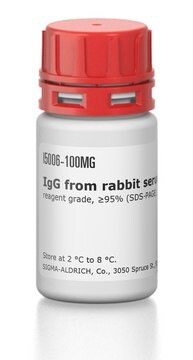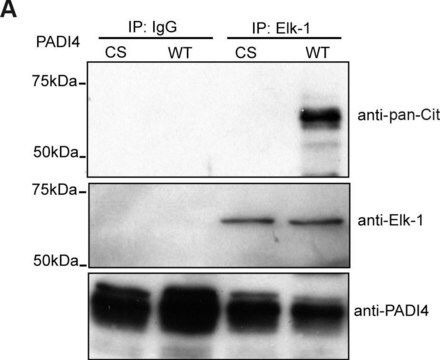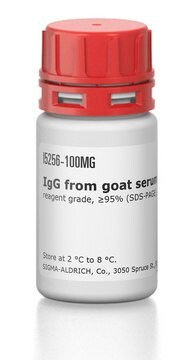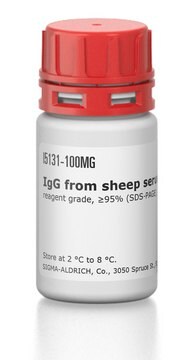I8140
IgG from rabbit serum
technical grade, ≥80% (SDS-PAGE), buffered aqueous solution
Sinónimos:
Rabbit IgG
Iniciar sesiónpara Ver la Fijación de precios por contrato y de la organización
About This Item
Productos recomendados
conjugado
unconjugated
Nivel de calidad
grado
technical grade
Análisis
≥80% (SDS-PAGE)
formulario
buffered aqueous solution
Condiciones de envío
dry ice
temp. de almacenamiento
−20°C
¿Está buscando productos similares? Visita Guía de comparación de productos
Aplicación
IgG from rabbit serum has been used:
- as a reference, standard or blocking agent in many immunoassays including dot blots, ELISA, Westerns, IEP, and immunodiffusion assays
- in arthus reaction
- in chromatin immunoprecipitation
Acciones bioquímicas o fisiológicas
Immunoglobulin G (IgG) regulates the immune responses such as phagocytosis and is also involved in the development of autoimmune diseases. IgG1 regulates complement fixation in mice.
Forma física
Solution in 0.01 M phosphate buffered saline, pH 7.2, containing 15 mM sodium azide
Nota de preparación
Rabbit IgG is purified via fractionation from pooled normal rabbit serum
Nota de análisis
Immunoelectrophoresis (IEP) is used to establish the identity of the Rabbit IgG. . A single major arc of precipitation in the gamma region is observed versus anti-rabbit whole serum and anti-rabbit IgG. Minor gamma arcs may be present versus anti-rabbit whole serum
Cláusula de descargo de responsabilidad
Unless otherwise stated in our catalog or other company documentation accompanying the product(s), our products are intended for research use only and are not to be used for any other purpose, which includes but is not limited to, unauthorized commercial uses, in vitro diagnostic uses, ex vivo or in vivo therapeutic uses or any type of consumption or application to humans or animals.
Código de clase de almacenamiento
12 - Non Combustible Liquids
Clase de riesgo para el agua (WGK)
WGK 2
Punto de inflamabilidad (°F)
Not applicable
Punto de inflamabilidad (°C)
Not applicable
Certificados de análisis (COA)
Busque Certificados de análisis (COA) introduciendo el número de lote del producto. Los números de lote se encuentran en la etiqueta del producto después de las palabras «Lot» o «Batch»
¿Ya tiene este producto?
Encuentre la documentación para los productos que ha comprado recientemente en la Biblioteca de documentos.
Los clientes también vieron
Valérie Bardet et al.
Haematologica, 91(6), 757-764 (2006-06-14)
Abnormal activation of several signal transduction pathways such as phosphoinositide 3-kinase (PI3K) and MAP kinases has been reported in acute myeloid leukemia (AML). To test new targeted therapeutics, it is critical to develop sensitive analytical tools to detect abnormal activation
Frances Rena Bahjat et al.
Arthritis and rheumatism, 58(5), 1433-1444 (2008-04-29)
To assess whether R788, an orally bioavailable small molecule inhibitor of spleen tyrosine kinase (Syk)-dependent signaling, could modulate disease in lupus-prone (NZB x NZW)F1 (NZB/NZW) mice via inhibition of Fc receptor (FcR) and B cell receptor signaling. R788 was administered
Janus Schou Jakobsen et al.
Genome research, 23(4), 592-603 (2013-02-14)
Dynamic shifts in transcription factor binding are central to the regulation of biological processes by allowing rapid changes in gene transcription. However, very few genome-wide studies have examined how transcription factor occupancy is coordinated temporally in vivo in higher animals.
Elena Matveeva et al.
Cell discovery, 2, 15046-15046 (2016-07-28)
Specialized chromatin structures such as nucleosomes with specific histone modifications decorate exons in eukaryotic genomes, suggesting a functional connection between chromatin organization and the regulation of pre-mRNA splicing. Through profiling the functional location of Poly (ADP) ribose polymerase, we observed
Lily Chien Wang et al.
DNA repair, 7(12), 1973-1981 (2008-09-13)
Fanconi anemia (FA) is a recessive genetic disorder characterized by hypersensitivity to crosslinking agents that has been attributed to defects in DNA repair and/or replication. FANCD2 and the FA core complex bind to chromatin during DNA replication; however, the role
Nuestro equipo de científicos tiene experiencia en todas las áreas de investigación: Ciencias de la vida, Ciencia de los materiales, Síntesis química, Cromatografía, Analítica y muchas otras.
Póngase en contacto con el Servicio técnico













